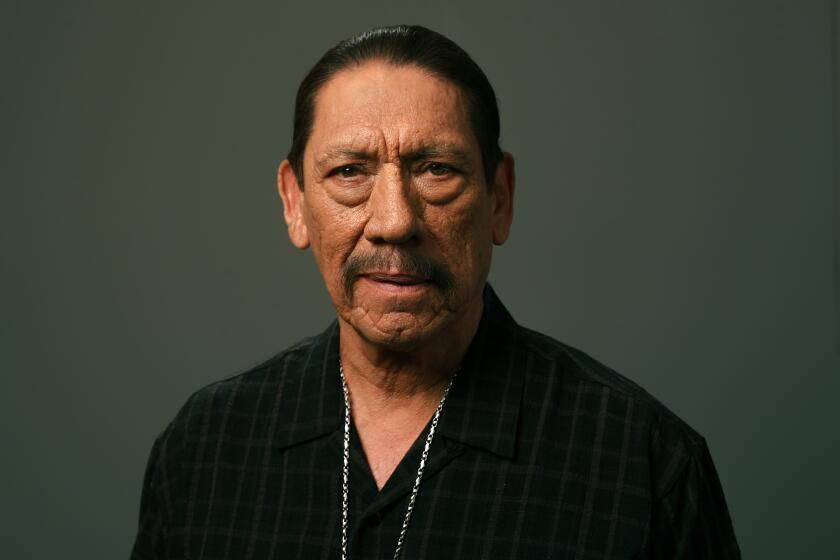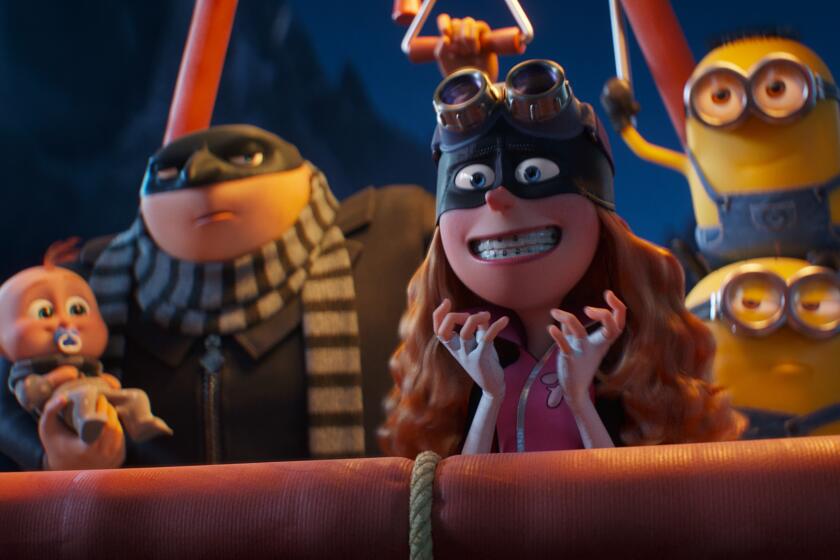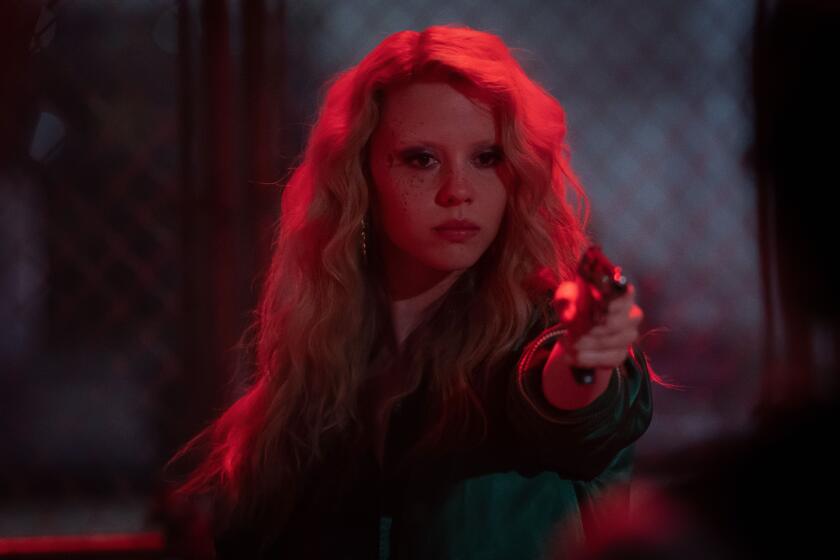Blood, no guts
It wasn’t quite as historic as watching crew members rearrange the deck chairs on the Titanic (or maybe it was), but I was in the audience on a cold January night in 1992 when Quentin Tarantino’s “Reservoir Dogs” had its Sundance Film Festival world premiere. * A traditional Q&A; session followed this very untraditional ultra-violent film, and a hand went up from what was clearly an anguished liberal seated near the back of the venerable Egyptian theater. How, he wanted to know, could Tarantino defend the level of violence on the screen? * “Defend it?” the director, never one to avoid an issue, roared back like a character in “The Treasure of Sierra Madre.” “I don’t have to defend it, I love it!” Period. Close quote. End of story. * Given the wild-eyed Old Testament-prophet fervor of that remark, it’s not a surprise that Tarantino has returned with “Kill Bill,” perhaps the most graphically violent film ever made by a mainstream American company, Disney-owned Miramax. What is surprising is the absence of any kind of sustained outcry about that unprecedented level of mayhem. Where’s that guy near the back when we really need him? * Defenders of the “Kill Bill” kind of violence like to characterize it as cartoonish and over the top. But special-effects work in this area has become so expert that the mayhem can’t be excused as being “stylized” anymore: It looks and plays terribly real. “Kill Bill” revels in its graphically amputated limbs, realistically lopped-off heads, a body count so high even Tarantino says it’s incalculable. * Did anyone mention blood? “Kill Bill” luxuriates in Old Faithful-style geysers of blood, gushers that bring to mind the oil well that made James Dean’s Jett Rink filthy rich in “Giant.” So much blood that even Tarantino, who’s been quoted as saying that this would be a great film for 12-year-old kids, found a way to have enough. “He picks up -- I swear -- 5 gallons of blood and pours it over my head,” actress Julie Dreyfus told Entertainment Weekly. “It took weeks to get it off.” * Except for unhinged responses like the unmistakably anti-Semitic attack on Miramax and Disney that appeared on the New Republic’s Web site, “Kill Bill” has been overall quite the media darling. Vanity Fair devoted thousands of words to respectfully investigating Tarantino’s psyche, Entertainment Weekly put his star Uma Thurman (the daughter, ironically, of an expert on Tibetan Buddhism) on its worshipful cover, and gossip doyenne Liz Smith typified it all when she gushed “the stylish, super-bloody, martial arts film hommage has reestablished Tarantino as a director to be reckoned with.” Thanks, Liz, I needed that.
Reasons for this lack of protest are not difficult to find. For starters, there are people who make money off this as well as people, largely young adult males, who, like Tarantino, can’t get enough of gore on screen. “Kill Bill” had a $22-million-plus opening weekend, the equally violent “The Texas Chainsaw Massacre” earned $29 million the following week, “Jason and Freddy” opened at the top of the charts, in fact it almost seems that not a week goes by without a film targeted to this free-spending audience segment.
For the record:
12:00 a.m. Nov. 5, 2003 For The Record
Los Angeles Times Wednesday November 05, 2003 Home Edition Main News Part A Page 2 0 inches; 28 words Type of Material: Correction
Film violence -- An article in Sunday’s Calendar section about violence in films misidentified the movie “The Treasure of the Sierra Madre” as “The Treasure of Sierra Madre.”
Then there is the Vanity Fair glitterati crowd, people who are more frightened of being labeled Not With It than Puritan Jonathan Edwards ever was at being found in the hands of an angry god. Finally there are the great majority of Americans, people who are ignorant of just how bloody things have gotten on screen because they have simply trained themselves via bitter experience to look the other way.
Lack of outcry
As someone who would give a lot to be among the ignorant but is compelled by occupation to sample these wares, I find it as difficult to speak up as to remain silent. Though it’s counterintuitive to believe, given film’s acknowledged power to influence hearts and minds, that the endless barrage of violence we’re subjected to has no effect on our society, people are frankly bored by hearing that. A kind of mayhem fatigue has set in, which is yet another reason for the lack of outcry. Naysayers are always considered a drag, and it’s likely Noah’s dinner invitations drastically declined the more he insisted that there really was a flood in everyone’s future.
There are, however, two points “Kill Bill’s” insistent violence brings up that are worth returning to. Most obviously, the film’s R rating underlines for about the millionth time how crass and bankrupt the Motion Picture Assn. of America’s rating system is.
When a friend asked me if I was surprised that this film, an acknowledged high-water mark in home-grown violence, didn’t get an NC-17 rating, I was surprised he even asked. No major American film has ever gotten that rating for violence, and no film ever will. It’s one thing to make yourself feel important by giving an NC-17 to a fringe operator like Rob Zombie and quite another to give a financially ruinous rating to a major player like “Gangs of New York” or “Kill Bill.”
Also, the major studios and directors know how to play the game, making a show of compromise by lopping off a few offending frames (often frames they included just so they could be lopped off) and getting the rating they want. It’s no wonder that Tarantino candidly told Entertainment Weekly, “You don’t have that many directors saying, ‘It was really great working with the MPAA on my really ... violent movie.’ But I respect where they’re coming from. They asked me to tone it down and I did.” Translation: I made out like a bandit, as did the MPAA, which can delude itself that it did something of value. It’s only the public that’s being soaked, ending up as unexpectedly drenched in blood as that poor actress. These forces are so eager to appease each other that if they were sitting across from each other in the Middle East, we’d have had peace in that region years ago.
Everyone in Hollywood knows the ratings system is an inefficient joke, but its flaws don’t matter enough within the industry for anyone to take on the system’s ancient parent, the stubborn, cranky and crafty Jack Valenti, always ready to pull out shopworn polling data that he insists prove that Americans couldn’t be happier with the system. What they are really saying is that at best it’s better (barely) than a sharp stick in the eye.
So, Jack, please don’t bother sending over another form letter citing those polls -- everyone who surveys public opinion knows you can get any numbers you want if you shade the questions and the context in which they’re asked. If you believe in the system as much as you say you do, why don’t you do something really brave -- stand up in front of an audience of concerned parents who’ve seen “Kill Bill” and convince them it’s not violent enough for an NC-17. Better yet, convince them that this film and the heartwarming “Billy Elliot” deserve exactly the same R rating. I’d love to hear your reasoning on that.
Is censorship impossible?
The reason I am so troubled by the ratings system is that I truly fear for the consequences if unchecked and bogusly rated violence continues to worsen on screen. Everything is cyclical in history, periods of repression alternate with periods of excess just as surely as night follows day. Nothing is forever, no matter how much we wish it was.
My worry is that the movie industry is so profoundly addicted to the enormous worldwide dollar sign violence represents it doesn’t want to hear about the potentially inescapable hole it’s digging itself into. My worry is that a truly charismatic conservative with a Moral Majority agenda will focus on the flood-tide of R-rated mayhem coming out of Hollywood and win a national mandate to stop the bloodbath by any means necessary and initiate the kind of censorship that no one in their right minds wants to see.
Just a few weeks ago I came across a relic of the last period of Hollywood censorship, a 1937 book called “Hollywood’s Movie Commandments” by Olga J. Martin, a woman who helped enforce them. “The moral element appears to have won the war for decency in film” she is pleased to report in her preface to a 301-page compendium intended to give writers “a clear idea of what may and what may not be utilized for the theme of a motion picture.”
Think that couldn’t happen again? All kinds of formerly sacrosanct liberal notions are under attack, and there’s no reason why violence-as-freedom-of-expression couldn’t be added to the list. Unless the studios find the nerve to at the very minimum regulate violence in a meaningful way, someone a lot less complaisant than Jack Valenti is going to do it for them. Never forget that the prophet Jeremiah, the man who lent his name to the jeremiad with his pessimistic fears for the future, lived to see his doleful prophecies very much come to pass.
*
Locked and loaded
“Kill Bill” is only the latest example of films that have stirred debate over violence. Here are three prominent examples.
‘BONNIE AND CLYDE’ (1967): Faye Dunaway and Warren Beatty starred; operatic slow-motion shootouts shocked audiences.
‘NATURAL BORN KILLERS’ (1994): Woody Harrelson and Juliette Lewis as murderers becoming celebrities.
‘STRAW DOGS’ (1971): Dustin Hoffman and Susan George play a couple who use violence to defend their home.
*
Kenneth Turan is a Times film critic.
More to Read
Only good movies
Get the Indie Focus newsletter, Mark Olsen's weekly guide to the world of cinema.
You may occasionally receive promotional content from the Los Angeles Times.







